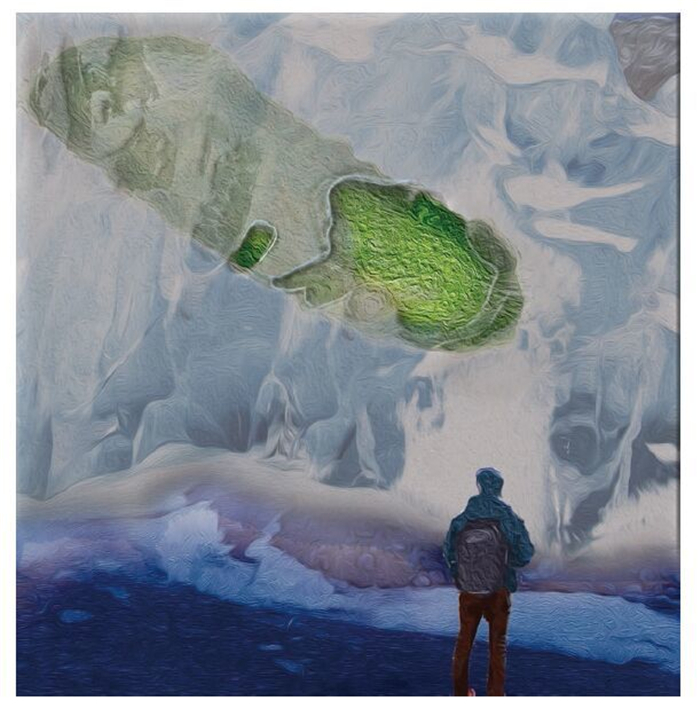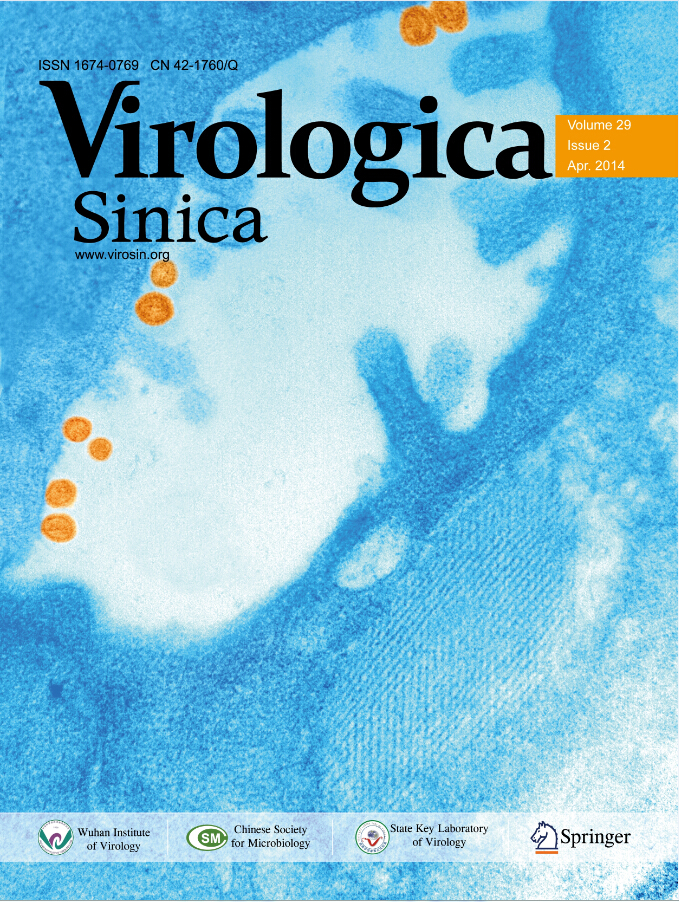-
A third type of giant DNA virus named Pithovirus was recently isolated from a > 30, 000-year-old permafrost sample in Siberia (Legendre M, et al, 2014). Pithovirus has a larger pandoravirus-like particle with 1.5 μm length and its adenine-thymine-rich genome is about 600 kb, which is surprisingly smaller than Pandoravirus. There is very slight genetic relationship between Pithovirus and Pandoravirus and their replication cycles significantly differ. The groundbreaking discovery of this ancient virus expands our understanding of giant DNA viruses and raises the concern of pathogen reemergence from permafrost regions because of the change of climate or the activity of human.

Figure 1. An ancient giant DNA virus, Pithovirus, was found from permafrost sample in Siberia. Pithovirus has an amphora-shaped particle with 1.5 μm length. There is almost no genetic relationship between Pithovirus and other giant DNA viruses. The discovery of this ancient virus is remarkable and expands our understanding of viruses.
Mimivirus was the first reported giant virus (La Scola B, et al, 2003). Remarkably, the viral particles are of micronsize and can be visible under a light microscope. Giant DNA viruses were isolated or rescued from Acanthamoeba. The first type of giant virus includes Mimivirus (La Scola B, et al, 2003), Megavirus (Arslan D, et al, 2011), Mamavirus (Colson P, et al, 2011), Moumouvirus (Yoosuf N, et al, 2012), and other variants (Desnues C, et al, 2012; Saadi H, et al, 2013) from Megaviridae with up to 0.7 μm diameter and up to 1.25 Mb adenine-thymine-rich genome. All of these viruses have an icosahedral-like protein capsid covered by an external fiber layer. The second type comprises two pandoraviruses, which were reported in 2013 (Philippe N, et al, 2013). They are amphora-shaped particles of 1–1.2 μm in length and have bigger guanine-cytosine-rich genomes of 1.9–2.5 Mb. Recently, a third type of giant DNA virus was isolated from a > 30, 000-year-old permafrost sample in Siberian (Legendre M, et al, 2014). This ancient giant DNA virus, named as Pithovirus, is a Pandoravirus-like particle of 1.5 μm length and its adenine-thymine-rich genome is approximately 600 kb, which is surprisingly smaller than Pandoravirus. The continuous discovery of giant DNA viruses expands our understanding of virus diversity.
HTML
-
Based on the evidences: 1) Both Pithovirus and Pandoravirus have amphora-like shape; 2) Pithovirus and Pandoravirus were rescued or isolated from the same amoeba species (Acanthamoeba castellanii); 3) Pithovirus was isolated from ancient sample while Pandoravirus from recent sample, it was initially supposed that these two viruses belong to the same family and have distant evolution relationship. If true, they will be a fantastic model to study the evolution of DNA viruses. However, Legendre et al.'s findings about comparative analysis of viral genomes and replication cycles reject this assumption (Legendre M, et al, 2014). The Pithovirus genome contains 467 genes (protein coding regions), which is much smaller than the 1, 502 and 2, 556 genes in the two Pandoravirus genomes (Philippe N, et al, 2013). Moreover, there is almost no genetic relationshipbetween Pithovirus and Pandoravirus. In addition, Legendre et al, compared the viral particle proteomes of Pithovirus and Pandoravirus. The results indicate that Pithovirus and Pandoravirus particles are made of entirely different sets of proteins and share only two homologous proteins with low identities (Legendre M, et al, 2014). Furthermore, there are significant difference about replication cycle within their host cells. The replication of Pithovirus occurs in the cytoplasm rather than in the nucleus of the infected cell and the shape of the nucleus is maintained (Legendre M, et al, 2014). In contrast, the replication of Pandoravirus has strong association with the machinery of cell nucleus. During the multiplication of viral particles, cell nucleus is reorganized and progressively vanished (Philippe N, et al, 2013).
-
Megavirus was firstly isolated from an aquatic sample in 2011 (Arslan D, et al, 2011), and belongs to Megaviridae like Mimivirus (Legendre M, et al, 2014). The results of comparative genomic analysis shown that Megavirus and Mimivirus share 594 orthologous proteins (Raoult D, et al, 2004; Arslan D, et al, 2011). It was initially proposed that all giant viruses share an ancient common ancestor. This hypothesis was abandoned by the discovery of Pithovirus in 2014 (Legendre M, et al, 2014) and Pandoravirus in 2013 (Philippe N, et al, 2013). Comparative genomics revealed that Pithovirus, Pandoraviruses and Megaviridae have almost no genetic relationship and giant DNA viruses should have different origins. The small DNA viruses as we known have various shapes and sizes of viral particle and different lengths of viral genome. A limited variety of giant DNA viruses reported during the past ten years reveal a similar biological characteristics. It is expected that a greater variety of giant DNA viruses will be discovered with the extensive surveillance of environment samples from different locations.
Pithovirus was isolated from the permafrost > 30, 000-year-old sample in Siberia. Legendre, et al. suggested that Pithovirus-like or novel amphorashaped virus might be screened in more ancient permafrost layers. Moreover, based on the traits of particle morphology and replication cycle, Legendre, et al. suggested that an uncharacterized endoparasite KC5/2 in amoebae described more than 10 year ago (Michel R, et al, 2003) may represent a modern Pithovirus relative. Amphora-shaped virus was expected to be diverse following the identification of various samples world-wide. Pithovirus was rescued from an ancient sample, while other giant viruses were rescued or isolated from different samples in different locations during the past ten years. This further suggested that giant DNA viruses have existed for a long time and are popular in our planet.
Giant DNA virus particles are of micron size and their genomes can be more complex than some eukaryotic parasites. These novel and remarkable biological traits have changed the traditional conception regarding virus definition. Recently, the amoeba genome (Acanthamoeba castellanii strain Neff; ATCC 30010; bait cell for Pithovirus and Pandoravirus) was reported (Clarke M, et al, 2013). The further study of viral and host genomes should facilitate an understanding of the novel evolutionary mechanism of giant DNA virus and the enigmatic link between virus and cell.
-
Due to the survival of Pithovirus (Legendre M, et al, 2014) and the finding of gene segments of the variola virus in a 300-year-old Siberian mummy (Biagini P, et al, 2012), public health risk should be concerned. That is the possibility that infectious viral pathogens might be released from ancient permafrost layers exposed by thawing, mining, or drilling (Legendre M, et al, 2014). It was proposed that amoeba viruses may serve as riskmarkers, and that the screening of amoeba-infecting viruses can be a safe and indirect method for the surveillance of pathogens in the Arctic region (Legendre M, et al, 2014). Recent progress in the field of metagenomics is fast with the development of next generation sequencing (NGS) techniques. The related tools or methods are also powerful for the surveillance of pathogens in environment samples. However, efforts should also be made to mine the data of unknown viruses with potential pathogenicity because metagenomic data always include a high proportion of sequences that show no database match.
-
All the authors declare that they have no competing interest. This article does not contain any studies with human participants or animals performed by any of the authors.














 DownLoad:
DownLoad: